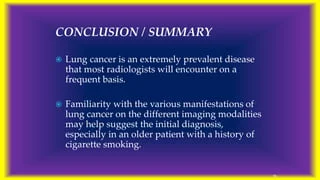Lung cancer is one of the most common and deadly types of cancer worldwide. It is responsible for a large number of deaths. This cancer primarily affects the lungs, but it can also spread to other parts of the body. By understanding the ways to prevent it, we can reduce its incidence.

Types of Lung Cancer
There are two types of lung cancer.
Non-Small Cell Lung Cancer (NSCLC)
This is the most common type of lung cancer, accounting for 85% of all cases. It has three subtypes.
Adenocarcinoma
Squamous Cell Carcinoma
Large Cell Carcinoma
Small Cell Lung Cancer (SCLC)
This type is less common, but it grows very quickly. Additionally, it is more aggressive than NSCLC.

Risk Factors
There are several risky factors of lung cancer.
Smoking:
This is the primary risk factor, responsible for about 85% of lung cancer cases. The risk increases based on how many cigarettes are smoked and how long a person has smoked.
Secondhand Smoke
Non-smokers exposed to secondhand smoke are also at increased risk.
Exposure to Radon Gas
Radon is a natural gas that occurs naturally. It can accumulate in homes and buildings, especially in areas with high uranium deposits.
Asbestos Exposure
Occupational exposure to asbestos is a known risk factor for lung cancer.
Air Pollution
Air pollution can also cause cancer. Its long-term exposure increases the risk of lung cancer.
Family History
Genetics also play a role in lung cancer. Those with a family history have a higher risk.
Previous Lung Disease
Conditions like chronic obstructive pulmonary disease (COPD) and pulmonary fibrosis can increase the risk of lung cancer.

Symptoms
https://www.linkedin.com/pulse/title-world-lung-cancer-day-raising-awareness-hope-healthier-sarin

Prevention Strategies
Although not all cases of lung cancer can be prevented, several strategies can effectively reduce the risk:
Avoid Tobacco Use
To prevent lung cancer, it is essential not to smoke. If you already smoke, you should quit. Quitting tobacco can be very helpful.
Limit Exposure to Secondhand Smoke
To protect yourself and others from lung cancer, avoid places where smoking is common.
Radon Testing
Where radon levels are high, homeowners should test for radon. If levels are elevated, they should take action.
Reduce Asbestos Exposure
If you work in industries where asbestos may be present, take safety measures. Follow regulations for handling asbestos.
Regular Health Screenings
Individuals at high risk (e.g., long-term smokers) should discuss lung cancer screening options with their healthcare providers. Low-dose computed tomography (CT) scans may help detect lung cancer at an earlier stage.

Advancements in Treatment
While lung cancer remains a formidable foe, advancements in medical research and treatment offer hope to patients and their families. Innovative therapies, such as targeted therapies and immunotherapies, have revolutionized lung cancer treatment and improved patient outcomes. These treatments aim to target specific mutations in cancer cells or boost the body’s immune system to fight the disease effectively.
Support and Empowerment
World Lung Cancer Day is also a time to show support and compassion to those battling lung cancer. Patients, survivors, caregivers, and healthcare professionals come together to share their experiences, provide emotional support, and inspire others with stories of hope and resilience.

Conclusion
World Lung Cancer Day serves as a poignant reminder of the urgent need to address lung cancer’s challenges through awareness, prevention, and research. By joining forces on this day, we can support those affected by lung cancer, inspire hope, and work toward a world where lung cancer is preventable, treatable, and ultimately defeated. As individuals and as a global community, let us continue to take strides towards a brighter, healthier future for all.

